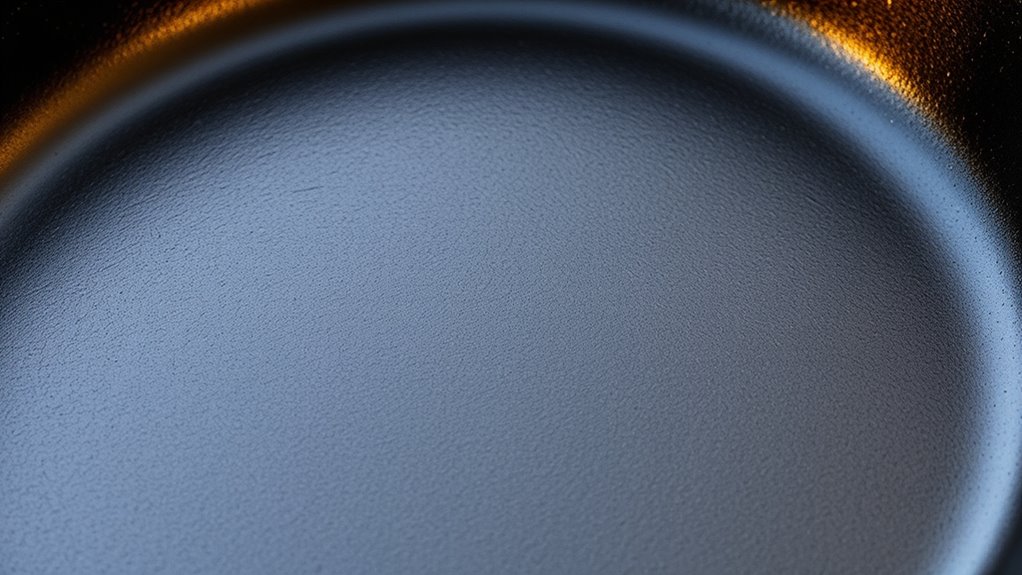Discover the secrets to transforming your cast iron skillet into a stick-resistant, long-lasting tool by mastering proper seasoning techniques. Use high smoke point oils like flaxseed or vegetable oil, apply thin layers evenly, and bake at about 350°F to build a durable non-stick surface. Avoid common mistakes like over-oiling or uneven heating. With consistent care and seasoning, your skillet will improve over time. Keep exploring to reveal even more expert tips and tricks.
Key Takeaways
- Proper seasoning builds a durable non-stick surface through layered oil polymerization at high temperatures.
- Use high-smoke-point oils like flaxseed or vegetable oil for effective, long-lasting seasoning layers.
- Apply thin, even coats of oil and bake at 350°F for one hour to develop a glossy, protective coating.
- Avoid over-oiling or using soap; clean with salt or hot water and dry thoroughly to prevent rust.
- Re-season regularly and store in a dry environment to maintain and restore optimal skillet performance.
Understanding the Importance of Proper Seasoning
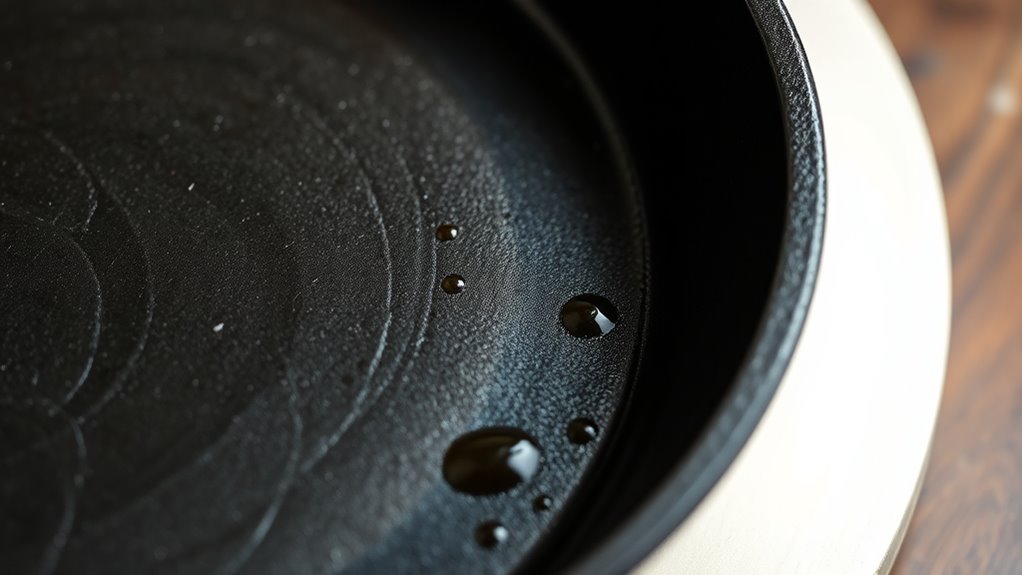
Have you ever wondered why some cast iron skillets develop a natural non-stick surface over time? It’s all about proper seasoning. Seasoning involves applying a very thin layer of oil to all surfaces of your skillet and baking it at around 350°F, which polymerizes the oil into a durable, non-stick coating. Multiple layers of seasoning build up, creating a glossy surface that prevents food from sticking and protects your pan from rust. Using oils with high smoke points, like vegetable or flaxseed oil, ensures effective seasoning and a hard, long-lasting coating. Proper seasoning also reduces metallic flavors by leaching less iron into your food. Regular maintenance and re-seasoning keep your skillet in top condition, ensuring it remains non-stick, rust-free, and lasts for years. Additionally, understanding the role of seasoning layers can help you achieve a superior non-stick surface and extend the lifespan of your skillet. Developing a well-established seasoning can further enhance the skillet’s performance and longevity. Building up a proper seasoning process over time is essential for creating a reliable non-stick surface and ensuring consistent results.
Selecting the Right Oils for Seasoning
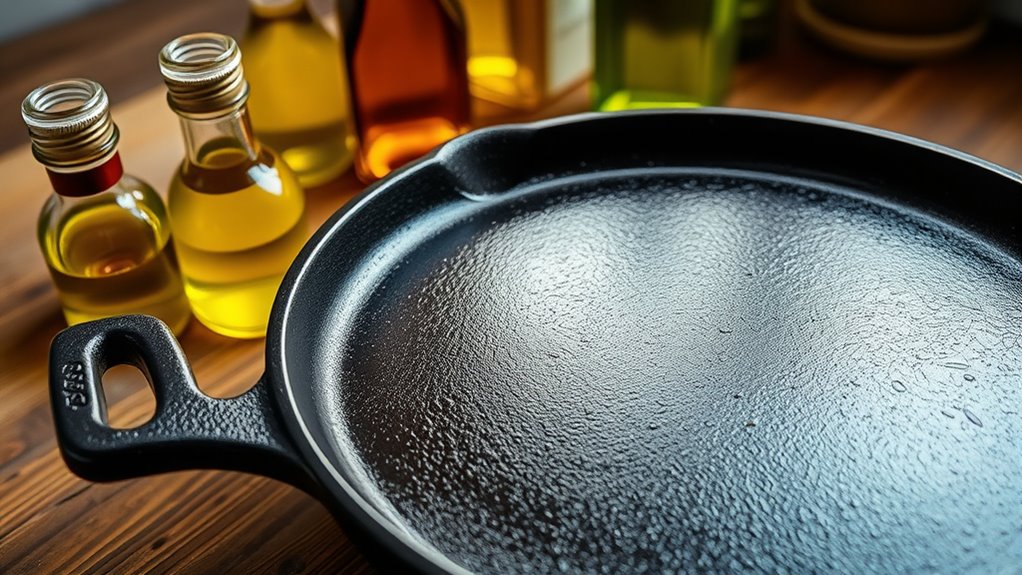
Choosing the right oil is key to a durable, non-stick cast iron skillet. You want oils with high smoke points, like avocado or grapeseed, to prevent burning, and those that polymerize well, like flaxseed, for a tough coating. Applying a thin, even layer guarantees your seasoning stays smooth and effective. Additionally, understanding Effective Email Marketing Strategies can help you share your tips with a wider audience. It’s also important to recognize that penetration testing involves simulated attacks that can reveal vulnerabilities in your seasoning process, ensuring your skillet remains resilient over time. Using appropriate oils also supports consistent polymerization, resulting in a more durable seasoning layer. Developing attention through consistent practice can further improve your seasoning results over time. Proper temperature control during application ensures the oil bonds correctly and creates a long-lasting, protective layer.
Smoke Point Considerations
Selecting the right oil for seasoning your cast iron skillet hinges on understanding its smoke point. The smoke point is the temperature at which an oil starts to produce smoke, signaling breakdown. Using oils with high smoke points, like vegetable or avocado oil, allows you to heat the skillet evenly without excess smoke or unpleasant odors. Oils with lower smoke points, such as olive oil, can smoke excessively during seasoning, resulting in a sticky or uneven coating. Choosing an oil with a suitable smoke point ensures proper polymerization, creating a durable, non-stick surface that resists burning and flaking over time. Additionally, understanding the effectiveness of home security systems can help you safeguard your investment in kitchen equipment, including your cast iron skillet. Gradual heating also minimizes the risk of thermal shock, which can crack or warp your skillet during the seasoning process.
Drying Oil Benefits
Drying oils like flaxseed and walnut are popular choices for seasoning cast iron because they polymerize well, creating a tough, long-lasting non-stick surface. A good drying oil forms a hard, durable coating that improves with each layer, offering better resistance to rust and sticking over time. Flaxseed oil, in particular, is prized for its high omega-3 content and ability to produce a smooth, glossy finish after multiple coats. Vegetable oils like canola, grapeseed, and soybean oil can also work, thanks to their high smoke points and strong film-forming qualities. However, oils with low smoke points, such as olive oil, tend to produce a sticky or uneven seasoning layer if overheated. Choosing the right drying oil guarantees your cast iron develops a resilient, long-lasting seasoning, especially when selecting drying oils with high smoke points and strong film-forming properties. Additionally, proper application techniques and understanding the polymerization process help ensure a superior seasoning layer that endures through countless uses. Using oil quality can also influence the durability of your seasoning, making it essential to select fresh, pure oils for best results. Understanding the chemical reactions involved in seasoning can further optimize the polymerization process for a durable coating. Moreover, controlling the application temperature during seasoning ensures the oil polymerizes correctly, avoiding sticky or uneven layers.
Oil Application Techniques
To achieve a smooth, durable seasoning layer on your cast iron skillet, it is essential to apply oil correctly. Mastering oil application techniques ensures the best results. First, choose oils with high smoke points, like flaxseed or grapeseed, for a hard, long-lasting coating. Second, apply a very thin layer of oil—using a cloth or paper towel—covering every surface evenly. Too much oil causes sticky buildup, while too little weakens the seasoning. Third, bake the skillet at 350°F to 400°F, allowing the oil to polymerize into a solid, non-stick surface. Repeating this process with thin coats builds a stronger layer over time. Proper oil application techniques are key to creating a seasoned skillet that improves with each layer. Additionally, understanding the importance of oil selection can help prevent common problems like sticking or flaking. Ensuring proper seasoning maintenance extends the lifespan of your skillet and enhances its non-stick qualities. Incorporating temperature management during the baking process also helps achieve an even, durable seasoning layer. Recognizing the role of curiosity in learning new cooking methods can make the process more engaging and rewarding.
Step-by-Step Guide to Seasoning Your Cast Iron
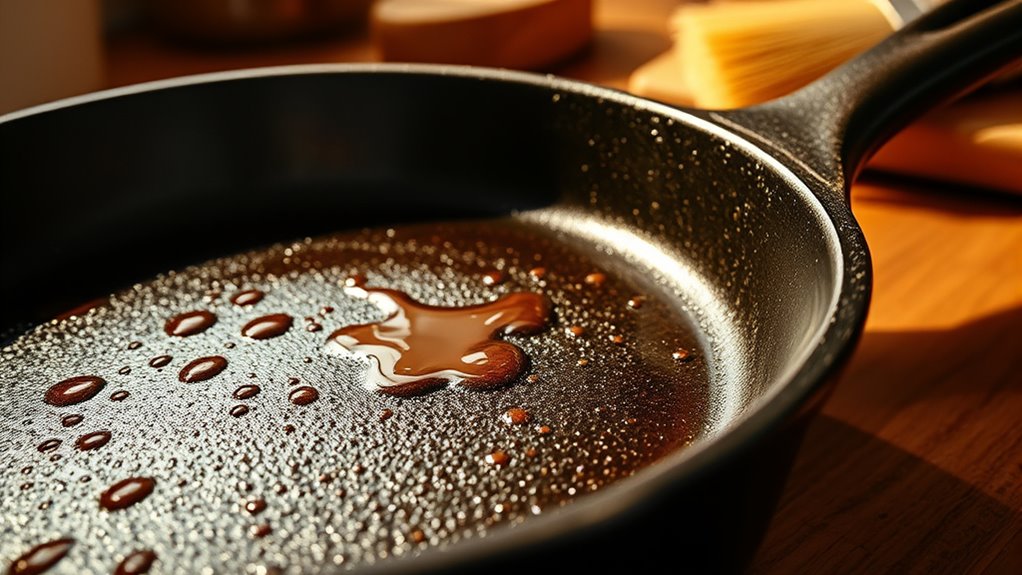
Before seasoning your cast iron skillet, make sure it’s thoroughly cleaned and completely dry. Proper care starts with removing any rust or residue to guarantee a smooth seasoning process. Apply a very thin, even layer of high-smoke-point oil, such as flaxseed or vegetable oil, all over the skillet, including the handle and exterior. Place the skillet upside down in a preheated oven at 350°F (175°C), with a sheet of aluminum foil on the rack below to catch drips. Bake for one hour, then turn off the oven and let it cool completely inside. This cooling period allows the seasoning to polymerize and harden. Repeating the oil application and baking process several times helps to build a durable, non-stick, and rust-resistant coating. Floating on water techniques can also be used to gently clean and maintain your skillet, especially if it’s been exposed to moisture. Additionally, regularly seasoning layers can enhance the skillet’s non-stick surface and longevity over time.
How to Achieve and Maintain a Non-Stick Surface
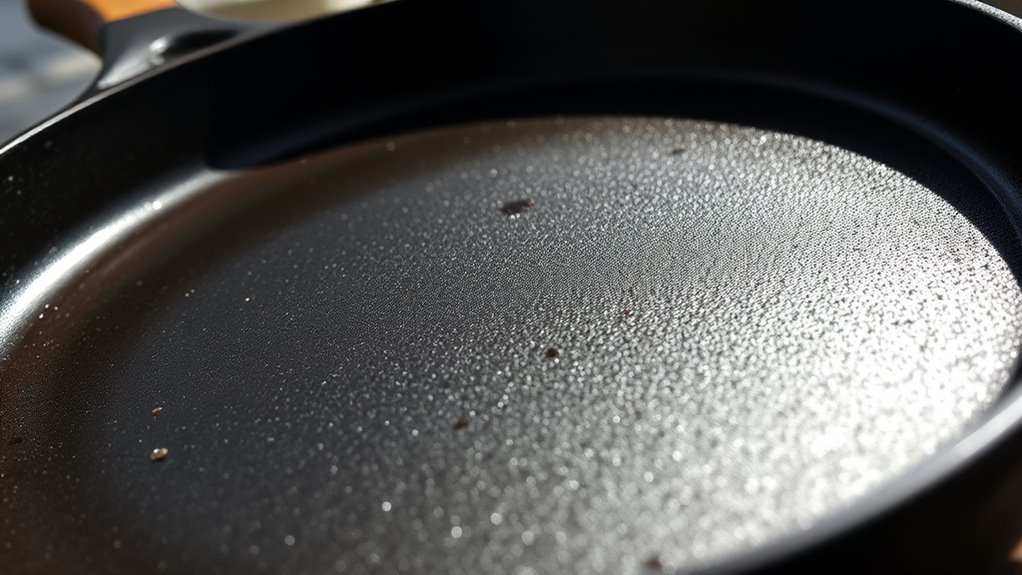
Ever wondered how to keep your cast iron skillet naturally non-stick? Achieving and maintaining that perfect surface involves a few key steps. First, apply a thin layer of oil like flaxseed or vegetable oil, then bake it at 350°F for an hour to create a durable, non-stick coating. Second, build up the surface with multiple seasoning sessions, carefully applying oil and baking each layer. Third, keep your cast iron skillets in top shape by cleaning with hot water and a gentle scrub or salt and oil—avoiding soap—and drying thoroughly. Lightly oil your skillet after each use to prevent rust and preserve the non-stick surface. Preheating before cooking also helps food slide right off, keeping your cast iron skillets in prime condition.
Common Mistakes in Seasoning and How to Avoid Them
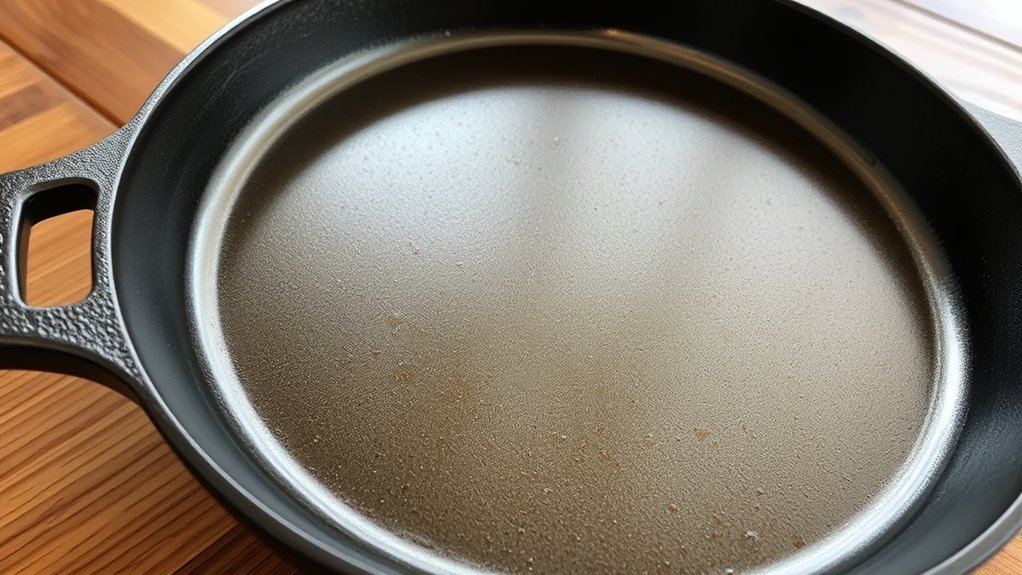
Many common mistakes can undermine your efforts to create a durable, non-stick cast iron skillet. Overapplying oil during seasoning can lead to sticky, uneven layers instead of a smooth surface. Heating the skillet above 400°F can burn the seasoning, causing smoke and weakening the coating. Skipping proper cleaning and drying before seasoning traps moisture, which results in rust and poor adhesion. Relying on one heavy layer of oil instead of multiple thin coats prevents proper polymerization, leaving your skillet sticky and uneven. Additionally, using the wrong oil, like butter or low smoke point oils, creates a fragile, unstable seasoning that deteriorates quickly. Avoid these mistakes by applying thin layers of high smoke point oil, heating at appropriate temperatures, and ensuring your skillet is clean and dry—key steps for successful cast iron cooking.
Re-Seasoning and Restoring Old or Rusty Pans
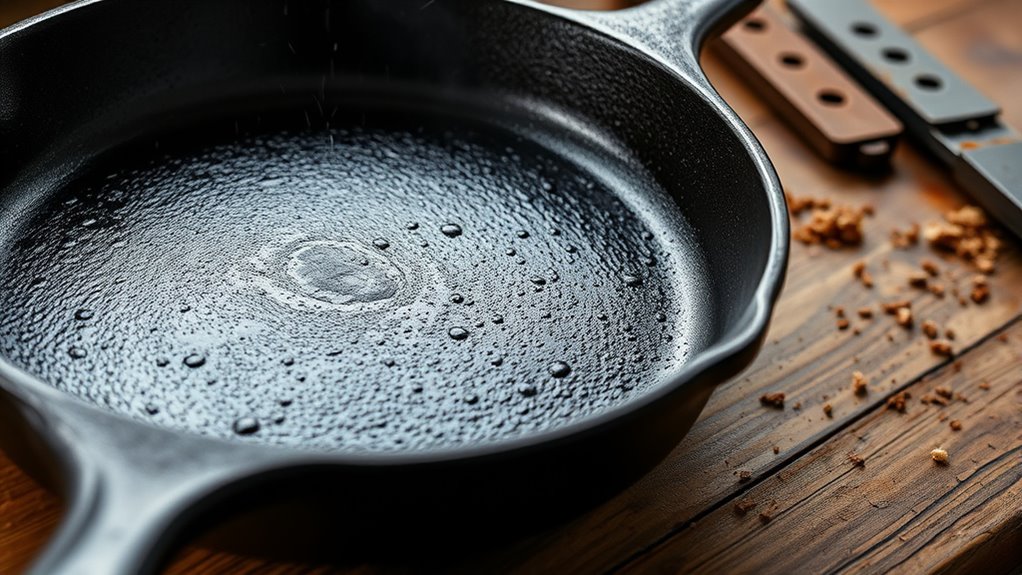
Restoring an old or rusty cast iron skillet starts with removing rust thoroughly—using steel wool, a chainmail scrubber, or even baking soda for heavy buildup. Once clean, dry it completely to prevent new rust. To re-season or restore, follow these steps:
- Apply a thin layer of high-smoke-point oil, like flaxseed or vegetable oil.
- Place the skillet in a 350°F oven for one hour, allowing the oil to polymerize into a durable coating.
- Repeat if necessary, building up multiple seasoning layers for a smooth, non-stick surface.
For heavily rusted pans, use baking soda or rust removers to strip old seasoning and rust before re-seasoning. Consistent maintenance guarantees your skillet stays rust-free and performs like new.
Tips for Long-Term Care and Maintenance
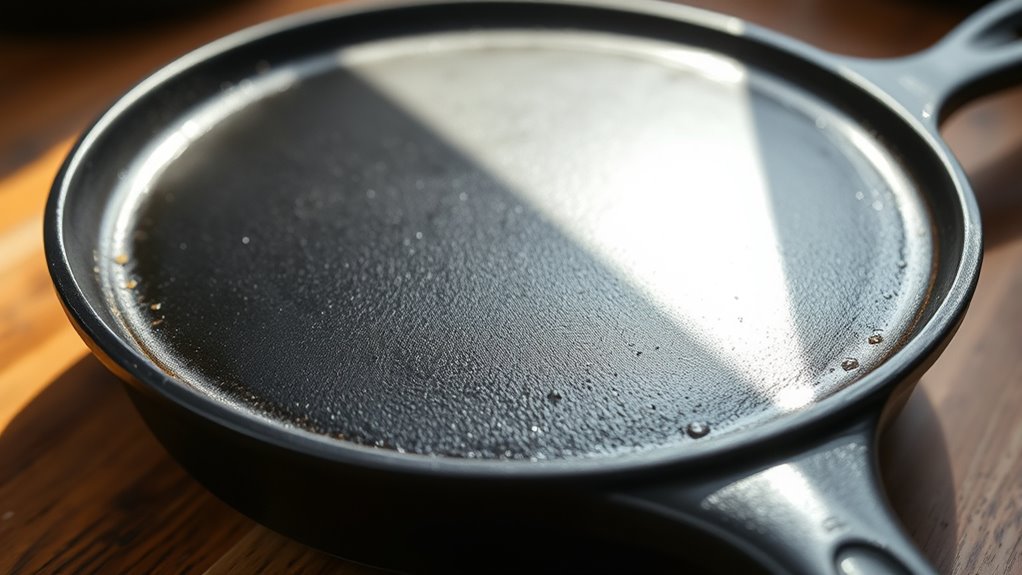
To keep your cast iron skillet in top shape, stick to a consistent seasoning routine and clean it properly. After each use, dry it immediately, lightly oil, and avoid soap to preserve the seasoning. Regular re-seasoning, especially after deep cleaning, helps protect against rust and maintains its non-stick surface.
Consistent Seasoning Routine
Establishing a consistent seasoning routine is essential for maintaining your cast iron skillet’s performance and longevity. Regularly applying a thin, even layer of oil after each use builds a durable non-stick coating. To maximize your seasoning efforts, focus on these steps:
- Use high-smoke-point oils like flaxseed or vegetable oil to create a harder, more durable surface.
- Bake the skillet at 350°F for at least one hour to polymerize the oil and reinforce the seasoning layer.
- Reapply oil and bake periodically to prevent rust, improve non-stick performance, and enhance flavor over time.
Sticking to this routine guarantees your skillet develops a glossy, long-lasting patina, making every use more enjoyable and effective.
Proper Cleaning Practices
Proper cleaning is essential for maintaining your cast iron skillet’s performance and preventing rust. You want to dry it thoroughly immediately after washing, using heat if needed, to keep moisture at bay. Use hot water and a gentle scrub brush or chainmail scrubber—avoid soap unless absolutely necessary—to preserve the seasoned surface. For stubborn residue or rust, scrub with coarse salt and oil or specialized cleaners like ring cleaner, then re-season as needed. After cleaning, apply a thin layer of oil and bake the skillet at 350°F for an hour to reinforce the seasoned surface and keep it non-stick. Store in a dry place, making sure the skillet remains lightly oiled to protect from moisture and maintain its seasoned, long-lasting quality.
Troubleshooting Seasoning Problems
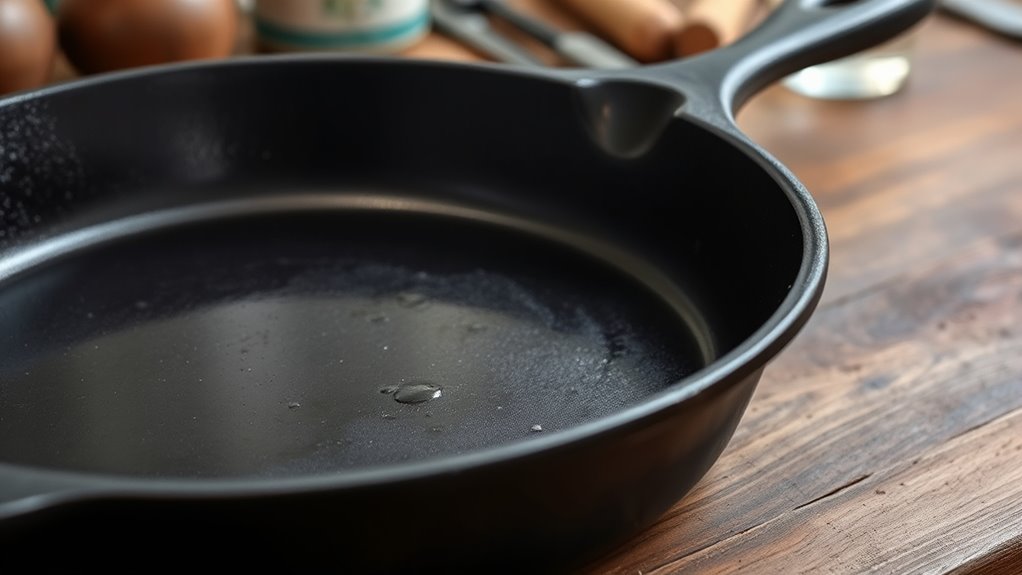
Seasoning problems often stem from common mistakes that can be easily corrected with proper techniques. One frequent issue is residue buildup, which can cause sticky spots or black patches. To fix this:
- Thoroughly scrub your skillet with salt or a chainmail scrubber to remove residual oil and debris.
- Avoid using excessive oil during seasoning; a thin layer ensures proper bonding.
- Maintain oven temperatures around 350°F during seasoning to prevent smoke and uneven layers.
If your skillet remains sticky or gummy, it’s usually due to applying too much oil or baking at too high a temperature. Consistent cleaning, minimal oil, and correct temperature control are key to resolving seasoning issues and achieving a smooth, durable coating.
Enhancing Your Cooking With a Well-Seasoned Skillet
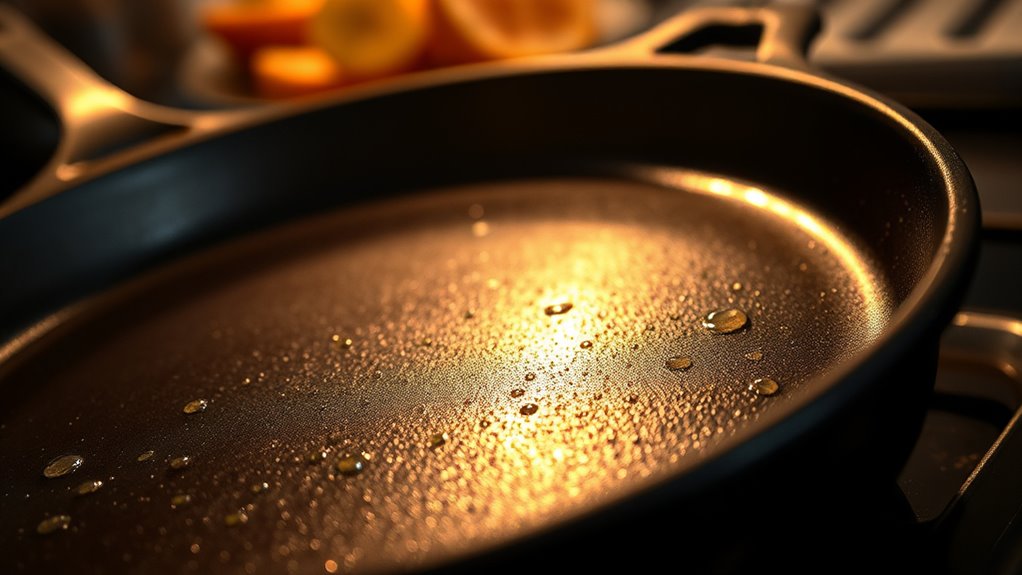
A well-seasoned cast iron skillet transforms everyday cooking into a seamless experience by providing a natural non-stick surface. To enhance your cooking, always start with proper care of your cast—apply a light coat of oil, like tablespoons of vegetable oil, every time you cook or clean. This process called seasoning builds a durable layer of seasoning that improves with each use, making stubborn bits easier to cook and clean. Regularly heating the skillet thoroughly and reapplying a thin layer of oil ensures the layer of seasoning becomes one with the cast iron, creating that glossy, black patina. Your skillet, a prized possession, can last for generations if maintained well. It’s worth every penny, taking your skills to the next level with a skillet that’s ready to deliver a non-stick surface for years old or new.
Frequently Asked Questions
What Not to Do When Seasoning Cast Iron?
When seasoning your cast iron, don’t use too much oil, as it can create sticky spots and rough surfaces. Avoid low smoke point oils like butter or olive oil, which can burn and ruin the coating. Never skip cleaning beforehand—residual food or rust interfere with proper seasoning. Also, don’t season in unventilated areas or at very high heat, and avoid applying thick layers without proper baking, which can cause gumming.
What Does Cast Iron Do to Your Body?
Think of your body as a garden, and iron as essential nutrients that help it flourish. When you cook with cast iron, tiny amounts of iron leach into your food, boosting your iron levels naturally. For most, this is a gentle, steady supply, much like watering plants. It supports healthy blood cells and energy, but if you have iron overload, too much can be harmful.
What Is the Best Oil to Season a Cast Iron Skillet With?
When choosing the best oil to season your cast iron skillet, you want one that creates a durable, non-stick surface. Flaxseed oil is excellent because it polymerizes into a hard coating with fewer layers. Vegetable oils like canola or grapeseed are also good options, thanks to their high smoke points. Just remember to apply thin layers and bake at the right temperature for the best results.
Why Do You Season a Cast Iron Skillet Upside Down?
Did you know that seasoning a cast iron skillet upside down reduces oil buildup by 50%? You do it this way to let excess oil drip off, ensuring a thin, even coating. It also improves airflow, which helps create a durable, non-stick surface. Plus, it prevents sticky spots and uneven seasoning, giving you a smooth, glossy finish that lasts longer and enhances your skillet’s performance.
Conclusion
With proper seasoning, your cast iron skillet becomes like a trusted friend, ready to cook up delicious meals and create memories. Keep practicing, avoid common mistakes, and give it the care it deserves. Think of it as nurturing a garden—patience and attention yield beautiful results. Soon, your skillet will perform like a well-rehearsed orchestra, turning everyday cooking into a magical experience you’ll cherish every time you cook.
